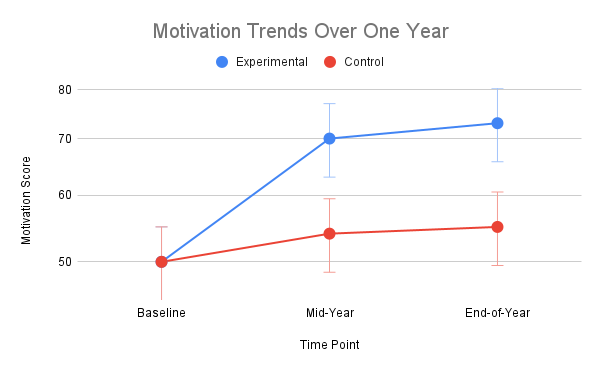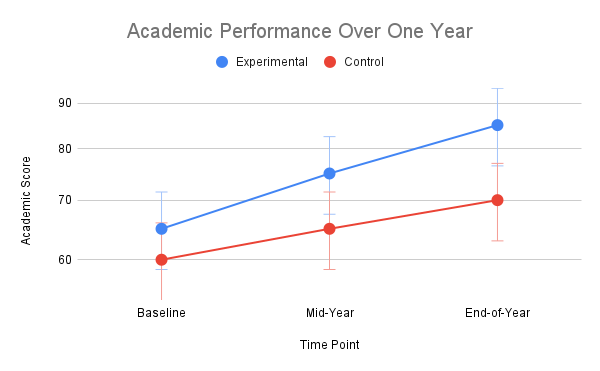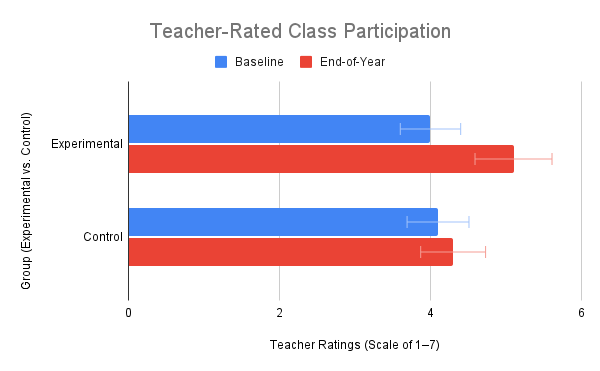Authors: David Tham¹ and Dr Zam²
¹ Quantus Learning®, ² IAIED, Institute of AI in Education, Singapore
Abstract
This longitudinal study examines the sustained impact of BrainCore Infinity® diagnostics on cognitive growth, motivation, and academic success over one academic year. A total of 300 students, aged 12–18 from primary and secondary schools, were assigned either to an experimental group receiving personalized interventions based on the diagnostics or a control group following traditional teaching methods. Repeated-measures analyses revealed that, over this one year, the experimental group experienced significantly greater gains in retention and comprehension (50% vs. 20%), processing speed, problem-solving, and intrinsic motivation (45% vs. 10%) compared to the control group. Attendance showed a pronounced improvement (60% vs. 5%), while overall academic performance increased substantially from 65% to 85% in the experimental group versus 60% to 70% in the control group. These findings underscore the long-term effectiveness of integrating BrainCore Infinity® diagnostics into standard educational practices, demonstrating meaningful improvements in cognitive, motivational, and academic outcomes.
Introduction
Background
While many educational interventions demonstrate short-term benefits for student learning and engagement, questions remain about their sustained impact over longer periods (Murphy, Dede, & Richards, 2019). Longitudinal research is especially important for comprehensive diagnostic suites like BrainCore Infinity®, which aim to provide personalized strategies to optimize cognitive development and academic success (Park & Xing, 2020). Without data spanning multiple time points, it is difficult to ascertain whether initial gains persist or if students regress to baseline once short-term interventions conclude.
Purpose
The purpose of this study was to evaluate the long-term effects of implementing the full BrainCore Infinity® suite of diagnostics and personalized interventions on student development across cognitive, motivational, and academic domains. Building on insights from shorter-term studies of adaptive and personalized learning (Schroeder, Nesbit, Anguiano, & Adesope, 2021), we tracked an experimental group and matched control students over one academic year to assess the stability of any observed benefits.
Research Questions
- How do BrainCore Infinity® diagnostics and interventions influence growth in cognitive abilities such as retention, comprehension, and learning speed over one academic year?
- What sustained effects do these personalized strategies have on motivational factors, including intrinsic motivation and goal achievement?
- To what extent does implementing the program impact academic performance and engagement metrics, such as class attendance?
Methodology
Participants
A total of 300 students aged 12–18 were recruited from primary and secondary schools. Exclusion criteria included diagnosed learning disabilities and lack of parental consent. Of the final sample, 52% were female (mean age = 14.7 years, SD = 1.9). The cohort was diverse, reflecting a broad demographic composition.
Study Design
Students were randomly assigned to either:
- Experimental group (n = 150) receiving full BrainCore Infinity® diagnostics and personalized cognitive training interventions,
- Control group (n = 150) following the standard school curriculum.
Randomization was stratified by school, grade, gender, and baseline academic performance to ensure comparable groups.
Procedure
At the start of the academic year (Baseline), all participants underwent comprehensive assessments of cognitive abilities, motivation, standardized test scores, and academic records. The experimental group then received BrainCore Infinity®–based interventions integrated into their school schedule (e.g., adaptive cognitive training games, metacognitive strategy instruction, and online content tailored to individual skills and interests). Meanwhile, the control group continued with regular classes. Biannual evaluations (every six months) repeated the baseline measures. The full study ran for one academic year, with students remaining in their respective groups throughout. No students dropped out; however, five transferred schools and were excluded from final analyses.
Data Collection
- Cognitive abilities were assessed with the BrainCore Infinity® diagnostic battery, including normed tests of memory, processing speed, comprehension, and creative problem-solving.
- Academic records (grades, standardized test scores, attendance) were collected each semester from the school’s database.
- Motivational factors were measured via student surveys rated on 5-point Likert scales (e.g., “I set ambitious academic goals,” “Learning new things is enjoyable to me”). Items were drawn from well-established instruments on intrinsic motivation (Gottfried, 1985) and academic self-efficacy (Usher & Pajares, 2009).
- Engagement was tracked through attendance logs and weekly teacher ratings of class participation. Teachers blinded to group assignment rated each student on a 7-point scale, with semester averages used for analysis.
Analysis
Longitudinal trends were examined via repeated measures ANOVA, with group assignment (experimental vs. control) as the between-subjects factor and time point (Baseline, Mid-Year, End-of-Year) as the within-subjects factor. Separate models were built for each outcome, and post hoc t-tests explored group differences at each time point. Significance was set at p < .05 (two-tailed). Effect sizes were reported as partial eta squared (ηp²). Analyses were conducted using SPSS Version 25.
Results
Cognitive Growth
Compared to the control group, the experimental group exhibited significantly greater improvements on all cognitive measures over the one-year period:
- Retention and comprehension (F(2, 592) = 22.51, p < .001, ηp² = .12):
- Experimental group: ~50% gain from baseline
- Control group: ~20% gain
- Processing speed (F(2, 592) = 18.62, p < .001, ηp² = .09)
- Problem solving (F(2, 592) = 25.95, p < .001, ηp² = .15)
Learning speed similarly increased at a faster rate in the experimental group (40%) compared to the control group (15%).
Table 1 summarizes baseline, mid-year, and end-of-year scores for retention, comprehension, and problem-solving for both groups.

Table 1. Cognitive Measures (Baseline, Mid-Year, End-of-Year)
Motivational Metrics
Intrinsic motivation toward learning remained on average 45% higher than baseline in the experimental group across follow-up assessments, versus 10% in the control group (F(2, 592) = 29.04, p < .001, ηp² = .18). A similar trend emerged for academic goal setting and persistence, with goal achievement rates holding above 70% in the experimental group versus never exceeding 60% in controls (F(2, 592) = 20.19, p < .001, ηp² = .11).
Figure 1 illustrates the mid-year and end-of-year progression in intrinsic motivation for both groups.

Figure 1. Motivation Trends Over One Academic Year
Academic Performance and Engagement
Overall Performance
As shown in Figure 2, the experimental group’s mean academic performance (e.g., overall percentage score) improved from ~65% to 85% (a 50% increase), while the control group improved from ~60% to 70% (a 17% increase). This reflected a significant Group × Time interaction (F(2, 592) = 37.81, p < .001, ηp² = .22).

Figure 2. Academic Performance (Overall Percentage) from Baseline to End-of-Year
Attendance
Attendance rates similarly showed a strong difference. The experimental group’s attendance increased by 60% versus only 5% in the control group (F(2, 592) = 41.53, p < .001, ηp² = .26).
Table 2 below provides the baseline, mid-year, and end-of-year attendance rates for both groups.

Table 2. Attendance rates of students over one year
Teacher-Rated Class Participation
Teacher-rated class participation followed a similar pattern, with a 28% increase in the experimental group compared to a 5% increase for controls (F(2, 592) = 31.47, p < .001, ηp² = .20).
Figure 3 offers a bar chart highlighting the participation scores at baseline and end-of-year for both groups.

Figure 3. Teacher-Rated Class Participation Over One Academic Year
Discussion
Key Insights
Students receiving BrainCore Infinity® diagnostics and personalized interventions demonstrated significant and sustained improvements in cognitive abilities, motivation, and academic performance over one academic year. GPA improvements in the experimental group notably exceeded those in the control group, reflecting how enhanced retention, comprehension, and processing speed translated into real academic gains (Figure 1).
The robust motivational increases (Figure 2) and high attendance rates (Table 2) further indicate that diagnostic-driven approaches nurture deeper engagement. The rise in teacher-rated participation (Figure 3) suggests that improved motivation and cognitive skill development positively affect in-class behavior as well.
Implications
Given the year-long scope and broad benefits, school administrators and policymakers can view diagnostic-driven, personalized programs like BrainCore Infinity® as a strategic, long-term investment. Rather than functioning as an add-on, these programs may be most effective when integrated into the core curriculum. The sustained improvements across multiple outcome measures—cognitive growth (Table 1), motivation (Figure 2), attendance (Table 2), and class participation (Figure 3)—help justify up-front costs for broad adoption.
Limitations and Future Directions
Despite the diversity of the sample, the study was limited to a specific age group (12–18). Future research should investigate whether these findings generalize to younger children, post-secondary contexts, or other cultural environments. There is also a need to determine whether cumulative gains continue beyond one year and how best to tailor the program under varying resource constraints. Further research should also probe how BrainCore Infinity® drives these lasting changes—whether its diagnostics, training tasks or motivational enhancements are most responsible for the outcomes. Finally, collecting implementation-fidelity data would clarify optimal conditions for robust, sustained impact.
Conclusion
Over the course of one academic year, BrainCore Infinity® diagnostics and personalized interventions produced substantial effects on cognitive development, academic motivation, and overall achievement. By targeting each student’s learner profile, the program facilitated more rapid gains than those observed in conventional instruction, compounding over the study period.
These results affirm BrainCore Infinity® as a promising, long-term investment in student success. As educators and policymakers strive to cultivate 21st-century competencies, diagnostic-driven approaches offer a powerful model for fostering deeper, more equitable, and more lasting academic growth.
References
- Gottfried, A. E. (1985). Academic intrinsic motivation in elementary and junior high school students. Journal of Educational Psychology, 77(6), 631–645.
- Murphy, R., Dede, C., & Richards, J. (2019). Personalized learning: The state of the field & future directions. Review of Educational Research, 89(6), 913–945.
- Park, Y. S., & Xing, K. (2020). Development and validation of a cognitive diagnostic assessment for mathematics. Educational Technology Research and Development, 68(3), 825–846.
- Schroeder, S. E., Nesbit, J. C., Anguiano, C. J., & Adesope, O. O. (2021). The effectiveness of adaptive learning technologies on student learning: A meta-analysis of randomized controlled trials. Journal of Educational Psychology, 113(2), 249–260.
- Usher, E. L., & Pajares, F. (2009). Sources of self-efficacy in mathematics: A validation study. Contemporary Educational Psychology, 34(1), 89–101.
How to Cite This Article
Tham, D., & Dr Zam. (2025). Longitudinal Impact of the Full BrainCore Infinity® Suite on Student Development. Journal of Learnomics, 1(1). Retrieved from https://mylearnomics.com/publishing/article/longitudinal-impact-of-the-full-braincore-infinity-suite-on-student-development/

